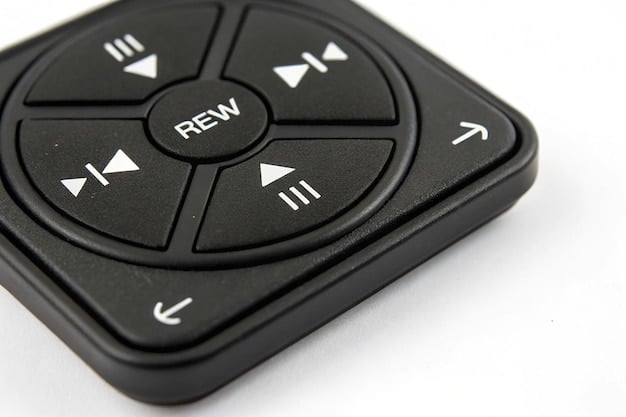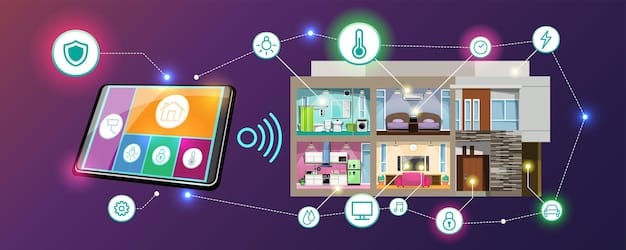Streaming Device Trends 2025: A Buyer’s Guide to Future Tech

The Latest Trends in Streaming Device Technology: A 2025 Buyer’s Guide explores emerging technologies such as 8K streaming, enhanced voice control, personalized content recommendations, and seamless integration with smart home ecosystems, providing consumers with insights to make informed purchasing decisions.
Staying ahead in the world of streaming technology means understanding the latest innovations hitting the market. This The Latest Trends in Streaming Device Technology: A 2025 Buyer’s Guide helps you navigate the cutting-edge features and make the best choice for your entertainment needs.
Exploring the Evolution of Streaming Devices
The streaming device landscape is constantly evolving, with new technologies and features emerging every year. Understanding this evolution is key to appreciating where the technology is headed and what to expect in future devices.
From Dongles to Dedicated Boxes
Initially, streaming devices came in the form of simple dongles like the Chromecast, offering basic streaming capabilities. Over time, dedicated boxes such as Roku and Apple TV emerged, providing more robust hardware and software features.
The Rise of Smart TVs
The integration of streaming functionality directly into smart TVs has blurred the lines between devices and displays. Modern smart TVs offer a comprehensive streaming experience, often eliminating the need for external devices.
- Enhanced processing power for seamless streaming.
- Improved Wi-Fi connectivity for buffer-free playback.
- Integration with voice assistants for hands-free control.
Today’s streaming devices are more powerful and versatile than ever before, offering a range of features that cater to different user needs. This evolution paves the way for exciting innovations in the coming years.
Key Technologies Shaping Streaming in 2025
Several key technologies are set to define the next generation of streaming devices. From enhanced video and audio quality to more intuitive user interfaces, these advances promise a more immersive and personalized streaming experience.

8K Streaming and HDR
The adoption of 8K resolution and High Dynamic Range (HDR) is set to become more widespread. These technologies deliver stunning picture quality with greater detail, contrast, and color accuracy.
Advanced Audio Technologies
Dolby Atmos and other advanced audio formats provide a more immersive sound experience. These technologies create a three-dimensional soundscape that enhances the overall viewing experience.
The continued development and integration of these technologies will drive the next wave of streaming device innovation, offering consumers unparalleled audio and video quality.
- Improved bandwidth capabilities to support 8K streaming.
- More efficient video codecs for reduced data consumption.
- Partnerships with content providers to offer 8K and HDR content.
The Impact of AI and Machine Learning
Artificial Intelligence (AI) and Machine Learning (ML) are playing an increasingly important role in streaming device technology. These technologies are being used to personalize content recommendations, optimize streaming performance, and enhance the overall user experience.
Personalized Recommendations
AI algorithms analyze viewing habits to suggest content that aligns with individual preferences. This helps users discover new shows and movies they might not otherwise find.
Voice Control and Natural Language Processing
Voice assistants like Alexa and Google Assistant are becoming more integrated into streaming devices, allowing users to control their devices and search for content using natural language commands.
- Predictive streaming to minimize buffering.
- Automated content organization and tagging.
- Enhanced search capabilities for finding specific scenes or actors.
AI and ML are transforming the way we interact with streaming devices, making the experience more intuitive, personalized, and efficient.
Smart Home Integration and IoT
Streaming devices are becoming increasingly integrated with smart home ecosystems, allowing users to control their devices and other smart home appliances from a single interface. This integration creates a seamless and connected entertainment experience.

Controlling Smart Devices Through Streaming Devices
Users can use their streaming devices to control smart lights, adjust the thermostat, and monitor security cameras, all from the comfort of their couch.
Seamless Automation
Integration with IoT platforms allows for automated routines, such as dimming the lights and turning on the TV when a movie starts.
This level of integration enhances convenience and simplifies the user experience, making streaming devices a central hub for the smart home.
- Compatibility with various IoT protocols.
- Enhanced security measures to protect user data.
- Integration with voice assistants for hands-free control of smart home devices.
The Future of Gaming on Streaming Devices
Streaming devices are emerging as a viable platform for gaming, offering access to a wide range of games without the need for expensive consoles. Cloud gaming services and improved hardware are driving this trend.
Cloud Gaming Services
Services like Google Stadia and Xbox Cloud Gaming allow users to stream games directly to their streaming devices, eliminating the need for downloads and installations.
Enhanced Processing Power
Newer streaming devices are equipped with more powerful processors and graphics cards, enabling them to handle more demanding games.
The future of gaming on streaming devices looks promising, with potential for even more immersive and high-quality gaming experiences.
- Improved latency for responsive gameplay.
- Support for Bluetooth game controllers.
- Partnerships with game developers to offer exclusive content.
User Experience and Interface Design
The user experience (UX) and interface design of streaming devices are critical factors in determining user satisfaction. Intuitive navigation, personalized content recommendations, and seamless integration with other devices are key elements of a great UX.
Intuitive Navigation
Easy-to-use menus and search functions make it simple for users to find the content they’re looking for.
Personalized Content Discovery
AI-powered recommendations help users discover new shows and movies that align with their interests.
A well-designed UX can significantly enhance the overall streaming experience, making it more enjoyable and engaging for users.
- Customizable home screens.
- Voice-activated search and control.
- Integration with social media platforms.
| Key Point | Brief Description |
|---|---|
| 📺 8K Streaming | Higher resolution offers sharper, more detailed viewing. |
| 🗣️ Voice Control | Hands-free control using voice commands for ease of use. |
| 🏠 Smart Home Integration | Control other smart devices via your streaming device. |
| 🎮 Cloud Gaming | Stream games directly without needing a console. |
Frequently Asked Questions
▼
8K streaming offers a significantly higher resolution than 4K, providing sharper and more detailed images. This results in a more immersive and realistic viewing experience, especially on larger screens.
▼
AI improves streaming devices through personalized content recommendations, voice control, and optimized streaming performance. AI algorithms analyze viewing habits to suggest relevant content and minimize buffering.
▼
Yes, many modern streaming devices integrate with smart home ecosystems, allowing you to control devices like lights, thermostats, and security cameras directly from your streaming device. This centralizes your home control.
▼
Cloud gaming lets you stream games directly to your device without downloading. Services like Xbox Cloud Gaming enable high-quality gaming experiences by processing games on remote servers and streaming the video to your device.
▼
Consider factors like resolution support (8K/4K), HDR compatibility, voice control, smart home integration, processing power, and the availability of apps and streaming services. Choose a device that fits your entertainment needs and budget.
Conclusion
As we look ahead to 2025, the trends in streaming device technology point towards a future of more immersive, personalized, and integrated entertainment experiences. By understanding these trends, consumers can make informed decisions and choose devices that best suit their needs.





